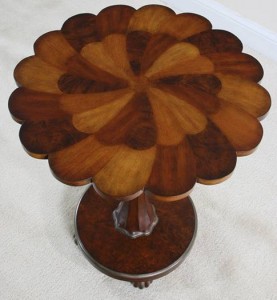
Truly an artform, marquetry is the use of veneer pieces to form pictures, patterns or other designs to cover a pre-existing structure. The structure in this case is fine furniture.
Parquetry, perhaps the cousin of marquetry, is a technique in which the veneers are arranged in repeating geometric patterns. It is most commonly seen as floor coverings (basketball courts, dance floors, etc.)
When quality furniture and someone masterfully skilled in marquetry are paired together, what can result is quite remarkable.
Marquetry and inlay differ in that the original material is not cut out or removed; it is simply covered. Conventionally constructed of stained wood veneers, other materials known to have been used for marquetry include colored straw, ivory, tortoise shell, brass, pewter and other metals as well as rare and exotic woods.
The most common marquetry technique is to take two different veneer sheets and glue them together (temporarily). Therefore, whatever pattern they are cut into, you’ll be left with two identical pieces of a different finish.
Wooden marquetry really took off early in the 16th century in Flemish areas, such as Antwerp, where their cabinet-making was revered as an artform.
The Prewswick Marquetry End Table by Ultimate Accents is just one of many examples of how modern furniture designers are taking on this centuries old process. Birch, cherry and ash burl veneers create an almost hypnotizing trio in a design that mimics a floral pattern.
Marquetry is an intricate art that has been around for centuries, and because of its enchanting beauty, will continue to be around for many years to come.
